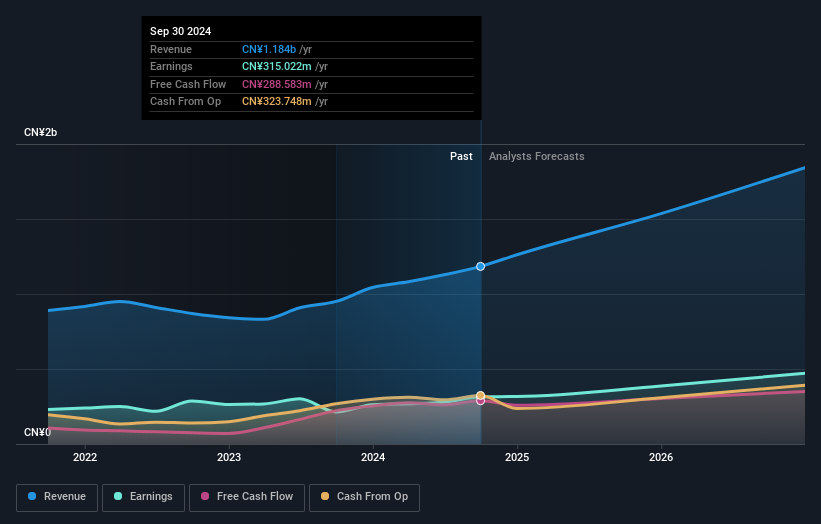Individual investors are Amoy Diagnostics Co., Ltd.'s (SZSE:300685) biggest owners and were rewarded after market cap rose by CN¥1.3b last week

Key Insights
- Amoy Diagnostics' significant individual investors ownership suggests that the key decisions are influenced by shareholders from the larger public
- The top 9 shareholders own 51% of the company
- 26% of Amoy Diagnostics is held by Institutions
If you want to know who really controls Amoy Diagnostics Co., Ltd. (SZSE:300685), then you'll have to look at the makeup of its share registry. And the group that holds the biggest piece of the pie are individual investors with 41% ownership. In other words, the group stands to gain the most (or lose the most) from their investment into the company.
As a result, individual investors collectively scored the highest last week as the company hit CN¥10b market cap following a 15% gain in the stock.
In the chart below, we zoom in on the different ownership groups of Amoy Diagnostics.
Check out our latest analysis for Amoy Diagnostics

What Does The Institutional Ownership Tell Us About Amoy Diagnostics?
Many institutions measure their performance against an index that approximates the local market. So they usually pay more attention to companies that are included in major indices.
As you can see, institutional investors have a fair amount of stake in Amoy Diagnostics. This implies the analysts working for those institutions have looked at the stock and they like it. But just like anyone else, they could be wrong. When multiple institutions own a stock, there's always a risk that they are in a 'crowded trade'. When such a trade goes wrong, multiple parties may compete to sell stock fast. This risk is higher in a company without a history of growth. You can see Amoy Diagnostics' historic earnings and revenue below, but keep in mind there's always more to the story.

Hedge funds don't have many shares in Amoy Diagnostics. Our data shows that Qianzhan Investment (Hong Kong) Co., Ltd. is the largest shareholder with 22% of shares outstanding. The second and third largest shareholders are Xiamen Yixiang Investment Partnership Enterprise (Limited Partnership) and Xiamen Keying Investment Partnership Enterprise (Limited Partnership), with an equal amount of shares to their name at 5.1%.
On further inspection, we found that more than half the company's shares are owned by the top 9 shareholders, suggesting that the interests of the larger shareholders are balanced out to an extent by the smaller ones.
While studying institutional ownership for a company can add value to your research, it is also a good practice to research analyst recommendations to get a deeper understand of a stock's expected performance. Quite a few analysts cover the stock, so you could look into forecast growth quite easily.
Insider Ownership Of Amoy Diagnostics
The definition of an insider can differ slightly between different countries, but members of the board of directors always count. Management ultimately answers to the board. However, it is not uncommon for managers to be executive board members, especially if they are a founder or the CEO.
Insider ownership is positive when it signals leadership are thinking like the true owners of the company. However, high insider ownership can also give immense power to a small group within the company. This can be negative in some circumstances.
Our most recent data indicates that insiders own less than 1% of Amoy Diagnostics Co., Ltd.. However, it's possible that insiders might have an indirect interest through a more complex structure. It is a pretty big company, so it would be possible for board members to own a meaningful interest in the company, without owning much of a proportional interest. In this case, they own around CN¥16m worth of shares (at current prices). Arguably, recent buying and selling is just as important to consider. You can click here to see if insiders have been buying or selling.
General Public Ownership
With a 41% ownership, the general public, mostly comprising of individual investors, have some degree of sway over Amoy Diagnostics. While this size of ownership may not be enough to sway a policy decision in their favour, they can still make a collective impact on company policies.
Private Company Ownership
Our data indicates that Private Companies hold 32%, of the company's shares. It's hard to draw any conclusions from this fact alone, so its worth looking into who owns those private companies. Sometimes insiders or other related parties have an interest in shares in a public company through a separate private company.
Next Steps:
It's always worth thinking about the different groups who own shares in a company. But to understand Amoy Diagnostics better, we need to consider many other factors.
Many find it useful to take an in depth look at how a company has performed in the past. You can access this detailed graph of past earnings, revenue and cash flow.
Ultimately the future is most important. You can access this free report on analyst forecasts for the company.
NB: Figures in this article are calculated using data from the last twelve months, which refer to the 12-month period ending on the last date of the month the financial statement is dated. This may not be consistent with full year annual report figures.
New: Manage All Your Stock Portfolios in One Place
We've created the ultimate portfolio companion for stock investors, and it's free.
• Connect an unlimited number of Portfolios and see your total in one currency
• Be alerted to new Warning Signs or Risks via email or mobile
• Track the Fair Value of your stocks
Have feedback on this article? Concerned about the content? Get in touch with us directly. Alternatively, email editorial-team (at) simplywallst.com.
This article by Simply Wall St is general in nature. We provide commentary based on historical data and analyst forecasts only using an unbiased methodology and our articles are not intended to be financial advice. It does not constitute a recommendation to buy or sell any stock, and does not take account of your objectives, or your financial situation. We aim to bring you long-term focused analysis driven by fundamental data. Note that our analysis may not factor in the latest price-sensitive company announcements or qualitative material. Simply Wall St has no position in any stocks mentioned.
About SZSE:300685
Amoy Diagnostics
Engages in the development and commercialization of diagnostics product for oncology in China and internationally.
Flawless balance sheet and good value.
Similar Companies
Market Insights
Community Narratives



